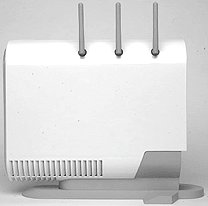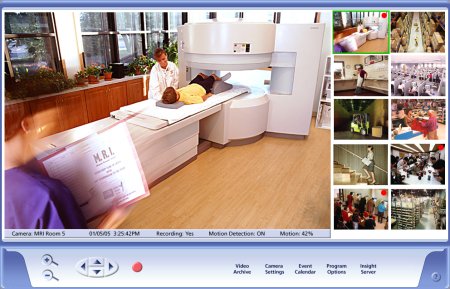Device Profile: Smartvue S2 video surveillance camera system
Jan 4, 2005 — by LinuxDevices Staff — from the LinuxDevices Archive — 16 viewsSmartvue has embedded Debian GNU/Linux in a home security and surveillance system that supports DVD-resolution video capture from secure, wireless IP-based cameras. The S2 system uses next-generation compression and wireless standards, along with image processing chips capable of dynamically adjusting the exposure setting of each pixel.

The S2 comprises a “DVM” and up to 10 wired/wireless cameras
According to Smartvue founder and CEO Martin Renkis, the S2 system is based primarily on open software and standards, and the company intends to make a C++ SDK (software development kit) available to Linux programmers wishing to extend system functionality with “smart surveillance” features, such as BLOB (binary large object) analysis.
 The S2 system centers around a “DVM” (digital video manager) system, pictured at right. The DVM includes a 1.4MHz Intel Celeron-based embedded computer that runs Debian 3.0r3 and handles image archiving and distribution, as well as providing a secure Web-based user interface. The DVM also includes a separate 300MHz PowerPC embedded computer, also running Debian 3.0r3, which interfaces wirelessly with up to 10 remote cameras. The PowerPC system also handles video down-sampling for output to Web-enabled mobile phones.
The S2 system centers around a “DVM” (digital video manager) system, pictured at right. The DVM includes a 1.4MHz Intel Celeron-based embedded computer that runs Debian 3.0r3 and handles image archiving and distribution, as well as providing a secure Web-based user interface. The DVM also includes a separate 300MHz PowerPC embedded computer, also running Debian 3.0r3, which interfaces wirelessly with up to 10 remote cameras. The PowerPC system also handles video down-sampling for output to Web-enabled mobile phones.
The S2 cameras are based on 300MHz PowerPC processors, and they also run Debian 3.0. The cameras communicate with the DVM using a pre-standard implementation of 802.11n, an evolving IEEE standard for wireless networking that aims to quadruple the throughput offered by current 802.11a and 802.11g standards. According to Renkis, Smartvue's implementation of 802.11n enables the S2 system to achieve an operating range five- to eight-times greater than 802.11a and 802.11g, while the separate, closed network places no additional load on existing wireless infrastructure.
Smartvue's 802.11n implementation uses MIMO (multiple input, multipe output) technology that can break video signals into multiple packets and send them over multiple radios, according to Renkis, enabling the system to “deal with a lot more interruption.”
The S2 cameras use Pixim's Digital Pixel System (DPS), which cincludes CMOS sensors along with a dedicated image processor said to dynamically adjust the exposure setting of each pixel individually, radically reducing under- and over-exposed areas within images. Smartvue claims the cameras produce images with a typical dynamic range of 95dB (120dB max). According to Renkis, DPS technology was developed at Stanford at a cost of over $50 million, and resulting in more than 70 patent applications.
The S2 cameras can be configured to use H.264 compression, a new video codec developed by the ITU-T's VCEG (video coding experts group). Renkis describes H.264 as an “amazing improvement” over MPEG4, and says the Smartvue cameras can deliver 30fps video at DVD resolution (720 x 480) over a 1.2 to 1.4Mbps network stream. He says the Smartvue cameras are the first surveillance cameras to support H.264.
The S2 cameras also support motion JPEG output, which Renkis says is preferred by some security professionals, because it does not do differential (inter-frame) compression, and thus produces video output that is more conducive to capturing freeze-frame still images.

S2's Web interface, with cameras set to use H.264 compression
(Click to enlarge)
The S2 cameras can be configured for 802.11a/b/g networking, and include RCA analog video camera outputs, as well as an RJ-45 jack for wired applications. The cameras feature Tamron Super Sharp IR day/night f1.4 lenses available in focal lengths of 2.8, 6, or 8mm, for use in as little as 0.3 lux of light, Smartvue says. The cameras capture images in 14-bit color, failing back to grayscale in low-light conditions. Other advanced features include area-definable in-camera motion detection, and a “favorable response” to supplemental infrared lighting. The cameras also feature built-in microphones.
According to Smartvue, the DVM offers a secure Web interface based on Apache Tomcat v4 and Apple's Darwin video server. User authentication can be handled using a patent-pending hardware key system. Additional open source software packages used include dhcp-client, perl, postgresql, ssh, OpenSSL, tomcat4, and J2SDK. The DVM can be connected to Ethernet networks through an RJ-45 port, or to a local host system through a USB 2.0 port.
The DVM's Web interface (screenshot) is based on javascript and other open standards, Renkis says, and supports simultaneous surveillance-on-demand, video recording, and playback of archival footage. The DVM can be configured to send alarms by email or to mobile phones. A single S2 DVR connected to 10 cameras can monitor up to 100,000 square feet, Smartvue says.
Smartvue claims that the S2 system can be installed in less than 30 minutes, because the system components recognize one another and automatically configure and optimize themselves for best performance.
The S2 DVR measures 11.5 x 11.6 x 3.8 inches (291 x 296 x 97mm). Cameras measure 6.2 x 5.2 x 1.6 inches (158 x 132 x 42mm), and are available with or without pan-and-tilt capabilities. The DVM includes status LEDs for all cameras, and is available with storage capacities from 80GB to 250GB.
According to Renkis, 18 engineers worked more than a year on the S2 system. He says the biggest challenge in using Linux was the lack of an H.264 runtime for Linux.
Availability
The S2 system will become available in 2005, through Home Director, a service company specializing in home networking systems. The DVM will be priced at $2,975, while cameras will be priced at $1,750 with 802.11n wireless capabilities, or $1,475 without.
Smartvue will demonstrate the S2 system at the Consumer Electronics Show in Las Vegas this week.
This article was originally published on LinuxDevices.com and has been donated to the open source community by QuinStreet Inc. Please visit LinuxToday.com for up-to-date news and articles about Linux and open source.